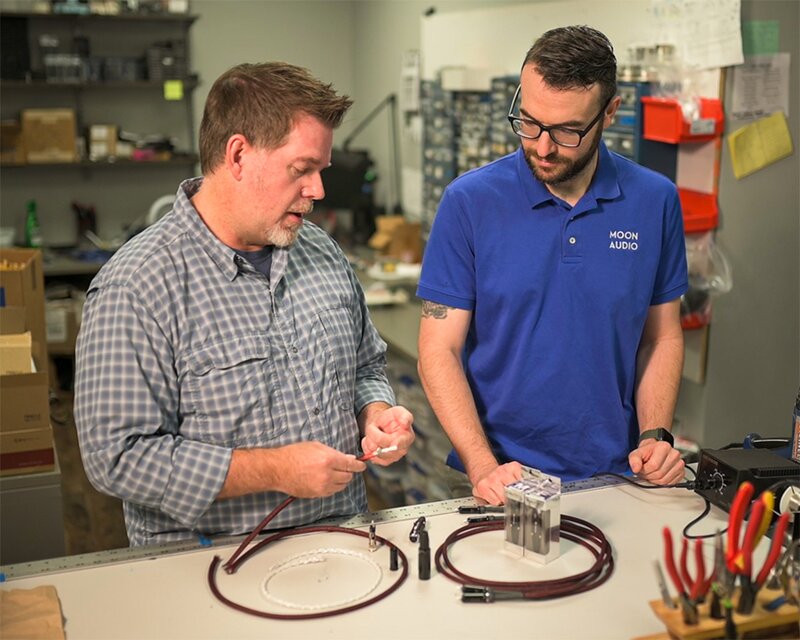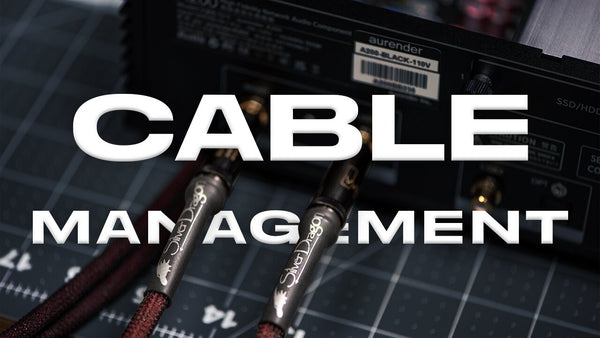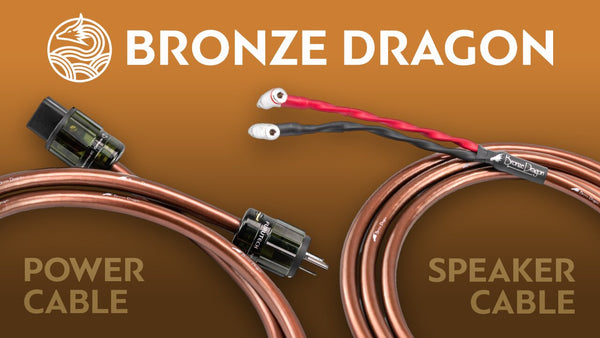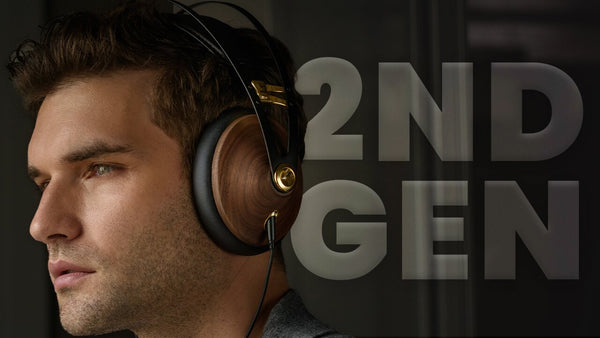A Complete Guide to Audio Cables: Types & Uses

Audio cables play a crucial role in connecting audio components. Even the most expensive and best-performing components can’t overcome the limitations of stock cables. Truly optimal performance requires high quality each and every step of the way, including your audio cables and audio connection accessories.
Everyone hears and experiences sound differently. However, there are ways to quantify the quality of audio cables. One example is the conductor materials used to make cables and their purity.
We can tell that quality matters in audio cables, and that would be enough if all audio equipment used the same type of audio cables. But that’s far from the case in reality. There are several common types of audio cables in use, each with its own unique qualities.
Let’s take a closer look at audio cable types. We’ll review several commonly used cables and explore key factors related to them, including signal transmission, balanced vs. unbalanced connections, and more.

Key Factors for Audio Cables
Sound quality and overall performance can vary greatly between audio cables. That’s true between different cable types and for single types of audio cables. Some of the most important factors that influence performance include:
Digital vs. Analog Signal Transmission
All audio cables carry sound information — the signal — from the source to the output. How a given type of audio cable transmits that signal has a major impact on sound quality. That’s true whether the source is a digital audio player, computer, analog turntable, or anything else, and no matter what type of speakers, headphones, IEMs, or other output device is used.
Digital vs. analog signal transmission is a key consideration for finding audio cables and a complete audio gear setup that offers the best sound for you. While perceptions of sound are subjective, at least to a degree, you can experiment and A/B test different options to create a setup that does the best job of pleasing your own ears.
So, what separates digital audio cables and analog audio cables, and how do the differences between them impact the sound you ultimately hear? and analog audio cables, and how do the differences between them impact the sound you ultimately hear?
Analog Audio Cables
Analog cables (like RCA and XLR cables) use a continuous electrical signal that is bound within a set voltage range, but can cover all values within that range, to reproduce the changing amplitude of sound waves. In other words, the electrical signal mimics actual sound waves.
Analog audio cables are known for offering a warm, “authentic” sound and are the original (and some say superior) method of transmitting sound waves.
Digital Audio Cables
Digital cables (like optical and USB cables) carry digital signals, meaning a series of 1s and 0s. These are discrete values as opposed to the continuous signal used in analog cables. By separating the sound waves into many small samples, digital audio can precisely reproduce a sound wave. The output device then converts this signal into sound waves.
While digital cables don’t have the same “authentic” output as analog cables, they can very closely approximate it.

Key Differences Between Digital and Analog Cables
Because analog cables carry an electrical signal, they face a few key issues, including:
- Signal quality loss as distance increases. Electrical signals degrade as the distance between the source and output grows longer.
- More vulnerability to interference. Analog cables are vulnerable to other nearby electrical devices interfering with the signal, causing issues like hums and noise.
Proper cable shielding and limiting the distance an analog signal must travel can help mitigate or eliminate these issues.
Digital cables don’t face these same issues. The signal doesn’t gradually lose quality over longer lengths of cable, although it still has a maximum distance. And, they’re less vulnerable to interference. They’re considered to be more reliable and consistent.
However, the warmth and authenticity of analog signals are enduringly popular. Digital signals can come very close, but can’t truly and fully replicate those qualities.
Balanced vs. Unbalanced Connections
We want to be clear that there isn’t a universal and objective difference in quality between balanced and unbalanced (also called single-ended) connections. In other words, balanced connections are not always better than unbalanced connections. Let me be clear. We are not comparing single-ended to balanced circuits here. We are just referring to the comparison with cables.
However, cables with balanced connections (like RCA and XLR cables) offer improved noise reduction because they use two dedicated signal wires alongside a ground wire, as music mastering service eMastered explains. This allows receivers with balanced connections to essentially average out noise and provide a cleaner output. This is called Common Mode Rejection.
Unbalanced connections lack this feature. Cables with unbalanced connections use a single signal wire and ground wire (which also carries some of the signal). They’re more susceptible to interference. However, all cables are shielded to help prevent noise.
Balanced connections offer benefits like better performance in environments with lots of noise and the need to use longer cables. Unbalanced connections meanwhile, are simpler and often less expensive. They can also produce a sound that you like better on a subjective level, at least in certain situations.
Our advice is to A/B test different options and experiment to find the best sound.
Remember that compatibility is key as well. When you already have most of your audio gear in place, simple factors like cable end types and audio plug sizes have a major influence over the types of audio cables you use.
Cable Quality & Materials
No matter the specific audio cable type, related audio jack sizes, type of connector, or any other factors, overall cable quality depends on a few key factors, including:
- The materials used to make the cable, including the shielding, connectors, and insulation.
- The quality of those materials.
- The design and construction — the effort and precision that goes into crafting each cable.

High-quality cables are carefully designed and built to address issues like signal loss and interference. It’s always important to look at product specifications, but in many cases, quality comes at a cost. The more expensive the cable, assuming it’s built well with the right materials, the more likely it is to deliver better sound.
Copper and silver are two of the most common materials used in audio cables. Audio-grade copper, of a higher quality than commercial-grade copper, is known for having a warmer sound and adding body to sound. However, it’s slower and offers less in the way of harmonic richness than silver.
Silver, meanwhile, can offer a lively, clear, and harmonically rich sound. However, it can also add a cold, thinner, or harsher quality at higher frequencies.
While cable construction has clear objective standards, the type of music or other audio content you listen to can influence the subjective quality of one audio cable material over another.
Common Types of Audio Cables
Your audio cable options are dictated in part by the other pieces of audio gear and audio connection accessories that make up your system and the connector types on those items. While you can’t simply choose any audio cable to pair with any source and output, you normally have options.
Choosing the right types of audio cables supports optimal performance from an objective perspective and for your individual listening experience. Common types of audio cables include:
RCA Interconnect Cables (Phono Cables)
RCA cables and connectors date back nearly 100 years, as PC Mag explains. They remain in service to this day, especially for basic consumer applications and with older electronics. However, RCA cables have been supplanted by more advanced audio cable types developed in the decades since. have been supplanted by more advanced audio cable types developed in the decades since.
Advantages of RCA Cables
- RCA connectors and cables are both inexpensive and widely available.
- These cables are widely used with consumer electronics and are often seen in entry-level and less-expensive options.
Disadvantages of RCA Cables
- RCA cables have unbalanced signal transmission, making them prone to interference.
- RCA cables experience signal quality loss over longer distances.
Ideal Use Cases for RCA Cables
- Home stereo systems.
- Home theater systems.
- Systems that are not prone to noise interference.
XLR Interconnect Cables (Balanced Cables)
XLR connectors and cables feature a balanced signal and are well-known for their durable and rugged construction. XLR cables were invented in the 1950s and remain a popular choice for specific audio and video applications. were invented in the 1950s and remain a popular choice for specific audio and video applications.
Advantages of XLR Cables
- XLR cables feature a durable design that makes them well-suited for demanding use cases, like live performances by touring bands.
- Balanced audio provides clearer signals.
Disadvantages of XLR Cables
- XLR cables are substantial — some call them bulky. They can be less convenient than other audio cable types, depending on the specific setup.
- XLR cables can be more expensive, although they also tend to be of a high quality.
Ideal Use Cases for XLR Cables
- Although also used in high-end home audio, XLR cables are commonly used for professional audio applications, such as:
- Live broadcasts and performances.
- Carrying audio signals in recording studios.
Optical Cables (TOSLINK Cables)
Optical audio cables carry a digital signal from the source to the output using optical fiber. When used, stored, and connected properly, these cables offer exceptional performance in transmitting signals across relatively short distances.
Connected properly, these cables offer exceptional performance in transmitting signals across relatively short distances.
Advantages of Optical Cables
- The fiber optic nature of optical cables leads to consistent and high-quality sound in digital audio systems.
- Their construction also makes them immune to electrical interference and associated noise issues.
- Optical cables are the least expensive option among all digital cables.
Disadvantages of Optical Cables
- Optical cables are more fragile than many other types of audio cables and can be easily damaged if bent too tightly. This can be a major issue in compact spaces.
- The nature of fiber-optic signal transmission limits the length of these cables to roughly 30 feet or 10 meters.
Ideal Use Cases for Optical Cables
- Home theaters.
- Soundbars.
- In general, high-end audio systems.
Coaxial Cables
Coaxial cables have been used since the era of the telegraph and continue to be a useful and effective option for transmitting audio and other signals. This digital cable includes built-in shielding that shares the same geometric axis as the conductor wire, giving it its name.
Advantages of Coaxial Cable
- Coaxial cables are especially reliable and durable.
- These cables can carry high-quality digital signals for longer distances than other options.
- As long as they have good shielding, coaxial cables are very resistant to interference and noise issues
Disadvantages of Coaxial Cables
- These cables are susceptible to noise issues if they’re not properly shielded.
- The qualities that make coaxial cables durable and well-shielded also make them bulky and hard to route.
- Coaxial cable connections are becoming less common in newer audio equipment and electronics.
Ideal Use Cases for Coaxial Cables
- From CD transport or other digital source to a DAC.
- DVD players.
- Home theater digital sources.
USB Cables
USB (Universal Serial Bus) cables support the transmission of high-quality digital audio and other signals. They’ve been widely adopted in consumer electronics and for professional audio environments, among many other uses.
Advantages of USB Cables
- High-quality USB audio cables are designed specifically to transmit digital audio signals, leading to very high-quality results.
- These cables can be used with a wide variety of devices, including digital audio converters, computers, and many others.
Disadvantages of USB Cables
- Generic USB cables don’t provide the same sound quality as those designed for audio use.
- USB extenders or powered hubs are needed to avoid signal loss over longer distances.
Ideal Use Cases for USB Cables
- Digital music production.
- Home studios.
- High-end home audio systems.
Get the Very Best Audio Cables
Ready to upgrade your sound? Explore our premium collection of audio cables and find the perfect match for your setup. Shop high-performance cables that make a difference at Moon Audio.


























